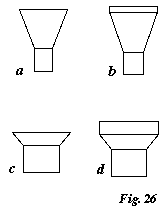CONSTRUCTION IX. THE CAPITAL 145
capital b, in which the slope is the same but the excess greater, is unsafe. But the 
§ 17. The steeper the slope of the bell, the thinner may be the abacus.
The use of the abacus is eminently to equalise the pressure over the surface of the bell, so that the weight may not by any accident be directed exclusively upon its edges. In proportion to the strength of these edges, this function of the abacus is superseded, and these edges are strong in proportion to the steepness of the slope. Thus, in Fig. 26, the bell at a would carry weight safely enough without any abacus; but that at c would not: it would probably have its edges broken off. The abacus superimposed might be on a very thin, little more than formal, as at b; but on c must be thick, as at d.
§ 18. These four rules are all that are necessary for general criticism; and observe that these are only semi-imperative,-rules of permission, not of compulsion. Thus, Law 1 asserts that the slender shaft may have greater excess of capital than the thick shaft; but it need not, unless the architect chooses: his thick shafts must have small excess, but his slender ones need not have large. So Law 2 says, that as the building is smaller, the excess may be greater; but it need not, for the excess which is safe in the large is still safer in the small. So Law 3 says
* In this case, the weight borne is supposed to increase as the abacus widens; the illustration would have been clearer if I had assumed the breadth of abacus to be constant, and that of the shaft to vary.
IX. K
[Version 0.04: March 2008]